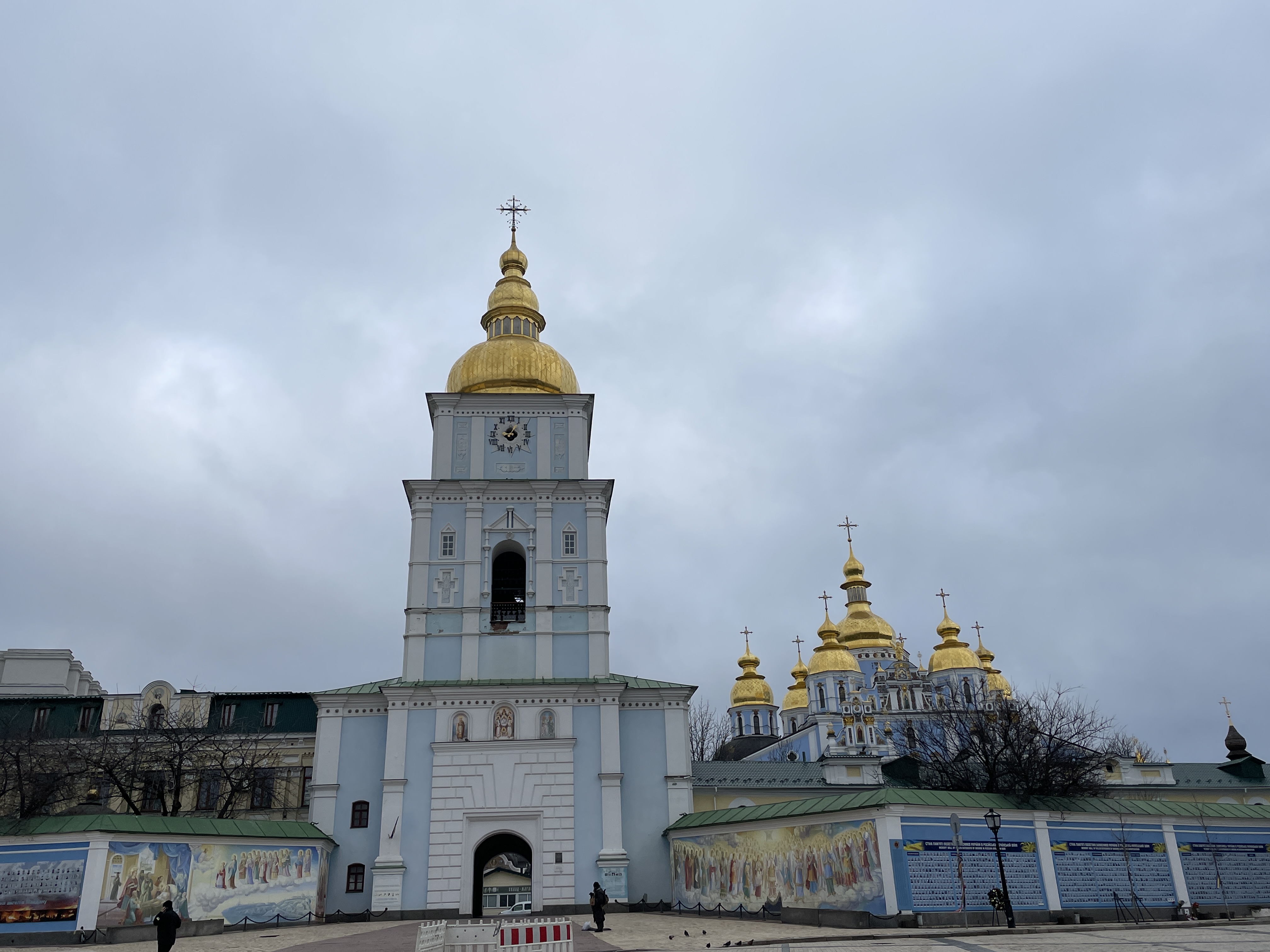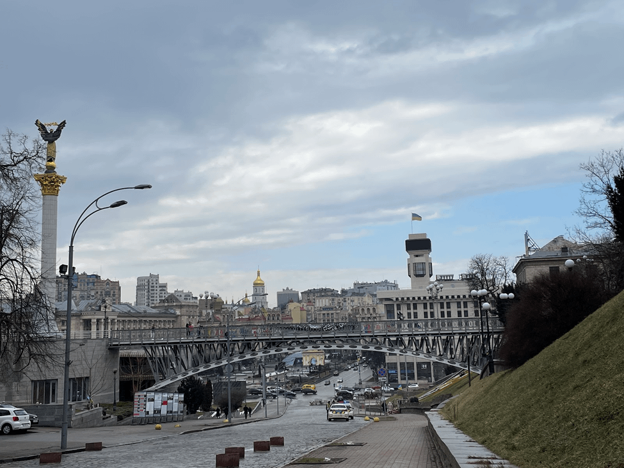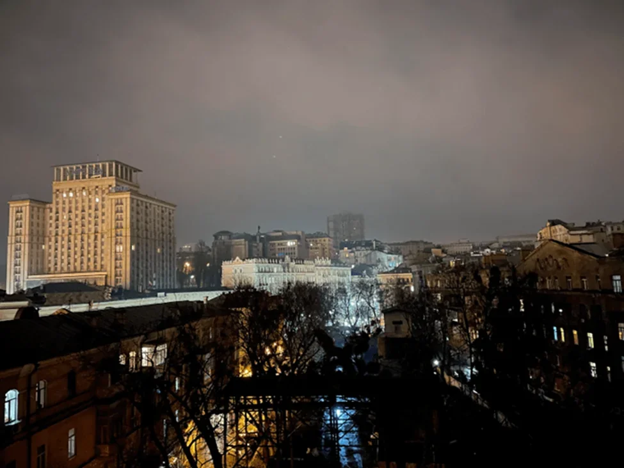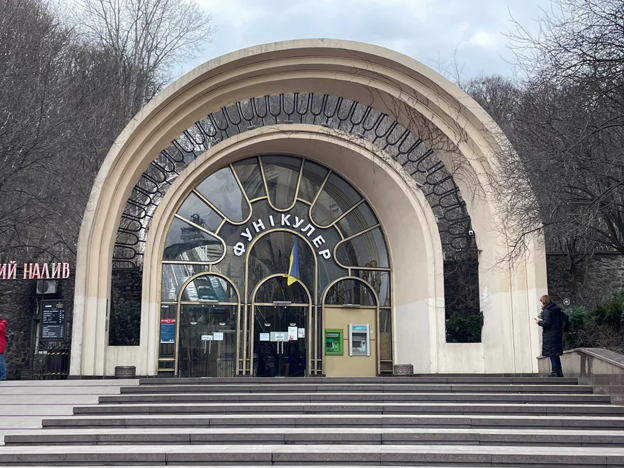
Disclaimer: I don’t endorse going to Kyiv at this time. Kyiv’s relatively safe, it was my seventh trip there, and I can get around okay, but I’m still a stupid American who would have been a headache for someone if things went sideways, wasting time and resources that could be better spent on Ukrainians.
I’ve been aching for Kyiv since last February 24. It’s my favorite city in the world and there are people there whom I long to see and who want to see me, but I had no intention of going until після перемога (pislya peremoha, after victory) because I’m terribly uncomfortable with the fact that someone would need to look after me if things went sideways. I went because one friend needed a favor that literally only I could do. Since I did go, I served as a mule in both directions so that at least my visit would be of some use to some people.
Go into this knowing that all of this is through the lens of an American visiting Ukraine for the seventh time; the sixth time since the Revolution of Dignity, russia’s illegal annexation of Crimea, and the start of the war in Donbas; the first time since July 2016.
In Part I, I told you about getting there. Now I’ll tell you about being there.
_______________________________
So what did you do there?
Y’know. Kyiv stuff.
In most respects it was similar to any other visit to Kyiv, except for the excruciatingly short duration (only 5 days), three gaping voids in the shapes of very dear friends who sought refuge in Poland and haven’t come back (though I did visit them before I flew home), and the two missile strikes.
I got to see all but two of the people I really wanted to see. They both had very good reasons for not coming to Kyiv–one illness and one case of being at the front–so even though I was disappointed to miss out on time with them, I can hardly object. I visited most of my favorite places and found a couple of new ones. Ate some phenomenal food. Wandered, because Kyiv is a marvelous city to wander in. Paid my respects to Nebesna Sotnya. Handed off things from the US and received things to take back with me. All the usual stuff.
I have to start with the FOOD. I’m not a foodie by any means, but you don’t know how I longed for proper chebureki and Crimean Tatar food in general.

After getting me settled into my apartment, Glib and I walked over to Musafir and I had a proper cheburek and Crimean Tatar food for the first time in almost seven years. You can’t know how good that first cheburek was. A couple days later we had our traditional fancy sushi dinner at Fujiwara Yoshi. Yes, I’m telling you this because they’re excellent restaurants you should go to when you visit Kyiv.
The next day, I got to hang out with Mykola! I totally failed to take pictures of the occasion!
We met on Maidan and took a stroll around the center. Down Khreshchatyk and up Prorizna, whose names are music to my ears, to Reitarska Street, where he showed me a couple of his favorite spots in the city. (I may have fallen a little bit in love with them, too.)
We ended the day with a sort of working dinner, during which I had the enormous pleasure of finally meeting documentary filmmaker and excellent company Kostiantyn Kliatskin, whom I sometimes help with his films’ English subtitles. Dinner was at Khutorets na Dnipri, a restaurant on a houseboat on the Dnipro. It serves incredible traditional Ukrainian food, including varieties of salo that were new to me, the best cherry varenyky I’ve ever had, and the second-best borsch I’ve ever had. (It was the best until I had my friend Katya’s mom’s Olya’s homemade borsch a few days later. That’s no reflection on Khutorets na Dnipri’s borsch. Borsch from a mom’s kitchen served at the family dining table is just going to be better, that’s all, especially if the family are very dear old friends and the mom is Olya.)

One day I unexpectedly found myself with hours to kill but needing to stay fairly close to home. No problem! Home was Maidan and there’s plenty in the area to keep me occupied. I started on Maidan proper, where Oleksandr “Sashko” Komyakhov’s graphic novel “Dad,” about some Maidanivtsi (protesters and revolutionaries) during the revolution, was displayed on huge steel panels in a spiral with the Independence Monument at its center.

On the left, part of a page from the graphic novel. See the sticker behind the helmeted head in the bottom right panel? The real one, or at least part of it, was on my apartment building’s elevator door. It dates from late 2013, shows disgraced ex-president Viktor Yanukovych, whom they ousted in the Revolution of Dignity, behind bars, and reads, roughly, “Yanukovych under arrest!” There’s some complicated Ukrainian wordplay at work there–Ukrainians are geniuses when it comes to wordplay–that I can’t adequately translate. (It’s a bit obscene, anyway.)
Then I took my traditional walk up Aleya Heroyiv Nebesnoyi Sotni to pay my respects to Nebesna Sotnya. I feel squirmy talking about that publicly. It’s a non-negotiable part of any trip to Kyiv, but it’s a private observance, something I deliberately carve out time to do by myself. I’m not even sure my friends there know I do it … but now all of you do.
I said in Part 1 that my favorite vantage point in the city is on Aleya Heroyiv Nebesnoyi Sotni, and that it’s been my favorite since my first visit almost 11 years ago. Then, it was because it made me feel like Kyiv was an exotic foreign capital. Kyiv feels homey instead of exotic now, but I always make it a point to stop and take in that view again, and it always hits me a bit like it did the first time. It was Instytutska Street then, and other than that view, there wasn’t anything interesting about it.

I love it differently now. It became Aleya Heroyiv Nebesnoyi Sotni because it’s where government goons slaughtered 48 Maidanivtsi on February 20, 2014. The street has been sanctified by murders and mourning, anguish and love, unity and respect. Now when I stand there and look across Maidan and up the hill to St. Sophia, I see the history laid out before me and know the history laid out behind me.
The street and the memorial have evolved over the years. I miss the improvisational nature of the earliest memorials, when the wounds were still raw: tributes to heroes from cities around Ukraine in black marker on small lengths of wood lined up along the wall opposite the clock, crowded with flowers, ribbons, and candles in colorful glass jars; photos of lost loved ones tucked into ziploc bags and tied to trees; paper angels dangling from branches and carnations stuck in the bullet holes.

But the permanent memorials that have been installed since then have been thoughtfully handled, I think. Even now, in the midst of the full-scale war, visitors still leave flowers, candles, and little trinkets, and the railings around the three gabbro slabs in front of the clock are still choked with ribbons. The continuity of observance is good. It feels right.

The memorial on the right, which is from 2014, reads:
My sons
My brothers
Forgive me for not saving you from the sniper’s bullet
20 February 2014
Slava Ukraini
_______________________________
This is another ungraceful transition from somber to cheerful. Kyiv will do that to you.
On our way back to Kyiv from Irpin the previous evening, my friends and I stopped to play in a graveyard of russian tanks destroyed by the UAF. Someone had tagged a few of them with “ETC” and a crude, stylized tryzub. I saw it and thought, “Pfffff. ETC is no Kilderov.”

Maxim Kilderov is the friend I mentioned in Part 1 who thought I’d be surprised at the number of Ukrainian soldiers in Kyiv, and that I’d find it reassuring. He’s an artist from Nova Kakhovka in Kherson Oblast in southeastern Ukraine. Nova Kakhovka has been occupied since day one of russia’s full-scale war. Kilderov and some of his friends immediately built an aid network to get food, medicine, and other necessities to the region’s most vulnerable residents, and occasionally get residents out for medical treatments, quite literally saving their lives. Kilderov had to leave Nova Kakhovka 55 days into the occupation because his own life was at risk. Now safe in central Ukraine, he continues to support that network, Humanity, remotely.

Oh, and he’s a little bit famous for spray painting on an abandoned russian tank.
Half a block from Aleya Heroyiv Nebesnoyi Sotni is a wall much decorated by graffiti artists and taggers. ETC had struck there, too, and seeing their tag inspired me to ask Kilderov if he’d left his mark anywhere around Kyiv.
He directed me to “some small buildings near the entrances” of Olimpiyskiy National Sports Complex. I hadn’t been to Olimpiyskiy since 2014 and had no idea what small buildings he was talking about, but it was a gorgeous day, Olimpiyskiy was close, and I still had a little time to roam, so I set out to see if I could find his work.
And I did! If you read this, Maxim: It was great fun to round the corner and find “you” there, friend. ж)
_______________________________
Missiles
A huge, muffled THUMP! woke me at 5:50 the next morning. I can’t accurately convey how instantly I knew that it was a strike of some kind. “Instantly” isn’t instant enough. “Planck time” comes close.
I talk to people in Kyiv every day and I follow the Kyiv city administration’s Telegram channel, so I always know when there are alerts, explosions, and all clears. I’ve learned not to worry until I see some variation of the word вибух (vybukh, explosion), and I no longer bother to check on my friends unless I see вибух in conjunction with the names of their raions (districts).
Leading up to my trip, I did wonder how I’d react if there were strikes while I was there. Calm like when I’m home and there are no вибухи near my friends? Chaotic like a panicked chicken? Frozen like the proverbial deer in headlights?
Now I know. I had a whole thing written out detailing my entire thought process, but I axed it. I sounded like a privileged war tourist and it made me feel gross. Here’s what it boils down to.
I sprang out of bed and out to the balcony to see what there was to see. Not much, as it turned out.

I stood there for a few minutes and thought about what to do. On the one hand, I was right on top of the Maidan metro station, which is a shelter. On the other hand, by this point I knew enough about the rhythms of russian attacks on Kyiv, such as they are, that I wasn’t really worried. I knew it had woken Glib but that he’d gone back to sleep. None of my other friends messaged me, so I wasn’t worried about them. Getting to the shelter seemed like a lot to do ten minutes after waking up, and it was cold and dark and I wanted coffee.
Coffee won. I made a cup, took it to the living room, and curled up on the couch with a blanket and my laptop, keeping an eye on the news and reassuring everyone back home that I was okay.
To everyone who made me promise I’d take shelter if there was an attack: sorry.
I suppose this calls my survival instincts into question, but I’m told that I handled it like a local except for not going back to sleep, and I’m secretly quite pleased about that.
I’ll tell you this, though. The elevator in my apartment building was a loud, clanky, thumpy affair, and the bedroom was placed such that I could hear it whenever it moved. Every time I heard it thumping up and down, I did briefly wonder if it was another strike. I was amused by it. The strike that woke me up wasn’t my first explosion. It wasn’t even the first explosion to wake me up in a foreign capital: on my first morning in Bogotá in August 2010, I woke up to a car bomb detonating seven blocks away. Neither was it my first explosion in Kyiv: I was there when Pavel Sheremet was murdered by car bomb in July 2016. (I didn’t hear that one, though. Just saw the aftermath.) That this one missile strike should make me a bit jumpy about a thumpy old elevator struck me as absurd.
But it sobered and angered me, too. One distant strike made a foreigner on a brief visit to a relatively safe city a bit jumpy about a thumpy old elevator. I think it was because the situation is so wildly different: two isolated assassination attempts are nothing, less than nothing, next to a war whose aim is erasure. I laugh even now at my jumpiness about the elevator, but underlying that is seething, impotent rage because there are people who don’t get to leave, or who didn’t leave soon enough–some of them people I love very much indeed, all of them people–who may never hear a stupid thumpy elevator again without a little stab of fear, and it’s for nothing but the deranged ambitions of a deranged old man. It’s for nothing.
Screw you, russia.
The THUMP! that woke me was a Kinzhal hitting an undisclosed infrastructure facility. There was another loud THUMP! about an hour later. I’m not sure what that one was, but it hit an apartment courtyard, wounding two. They were part of russia’s largest strike on Ukraine in months: 84 missiles and a bunch of Shahed drones. It wasn’t super effective.
Sucks to suck, russia.
The air alert ended a couple hours after the second strike and then, like almost everyone else in Kyiv, I just … did my day. I met Anya and Nataliya for coffee in Globus, the mall under Maidan. Then I walked down to the funicular station at Poshtova Ploshcha, happily anticipating a ride up the hill to Mykhailivska Ploshcha, where there’s a display of ruined russian armored vehicles.

Another air alert sounded a few minutes before I got to the funicular station, though, shutting the thing down until the all clear. A small crowd of us waited for about 20 minutes before collectively giving up and flocking silently to the adjacent metro stop–not to shelter, but to get to wherever we needed to be.
No funicular for me. No destroyed russian tanks for me. And no stopping for toilet paper on the way home for me, because the supermarket Novus, and in fact all of Globus, closes during air alerts. But I did get a very nice shawarma from one of the little restaurants dotting Maidan for lunch, so it wasn’t a total wash.
After lunch, I met with Tanya, Igor, and Ulyana all too briefly before rushing off to meet Julia at the National Opera House for a performance of the ballet Lilea. Julia made it a point to show me where we’d take shelter in the opera house in the event of, quote, “bock-bock,” but that was the only unusual thing about the evening. (I had a brief, confused vision of chickens overrunning the theatre, but then I realized that she meant explosions.)
And that was it, really. A day that started off with strange and locally frightening events turned into a normal day in Kyiv made extra pleasant by seeing so many faces I like.
_______________________________
I made it up to Mykhailivska Ploshcha to see the destroyed russian equipment on this trip’s final morning in Kyiv. It’s a savagely delicious assortment of torn up, burnt out, rusted hulks. Did I think to get pictures of the collection as a whole? I did not, because I was too busy reading the messages scrawled on them. The rage is palpable.

The square’s monument to the almighty Olga of Kyiv has been sandbagged for protection since the start of the full-scale war. It’s become a sort of community bulletin board, a place to hang your protest banners, pleas for help, and volunteer recruitment ads.

It was while I was taking in the banners that I finally had a moment of true fright.
An air raid siren began to wail. I pulled out my phone and took a video, figuring my friends at home would be interested. And then, just when the siren stopped, the bells of St. Michael’s started.
On December 11, 2013, the brutal Berkut special police stormed Maidan in an attempt to disperse the protesters with sickening violence. Bellringer Ivor Sydor flew up the stairs to the belltower and rang the bells nonstop from 1 am to 5 am, “urging people to go to the main square of the capital and support the protesters who were threatened by Yanukovych’s security forces.”
To me, the bells of St. Michael’s mean “ALERT! DANGER! BAD THINGS HAPPENING TO KYIV!” Hearing them directly on the heels of an air raid siren had my heart racing and my eyes scanning the sky for bombers …
… and then I remembered that church bells often toll the time. I pulled out my phone again and checked the time. It was 9:15. The bells were announcing that it was 15 minutes past the hour.
I laughed at myself and went to get some coffee.
And that’s all I have to report, really. I spent that afternoon goofing around and drinking severely weird beer with old friends before catching the train back to Warsaw, which is the best possible way for a visit to Kyiv to end.

I don’t think I can wait until післа перемога to get back.
One final note.

